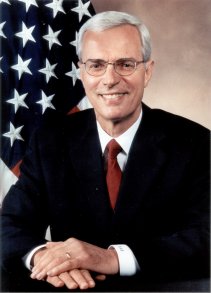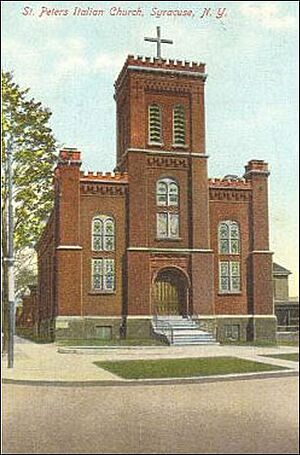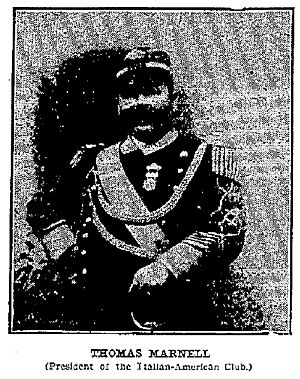Italians in Syracuse, New York facts for kids
Many people of Italian heritage live in Syracuse, New York. There are almost 22,000 people with Italian roots in the city. They mostly live around the area known as Little Italy and the Northside of Syracuse.
Italian immigrants first came to Syracuse in 1883. They had worked on building the West Shore Railroad, which connected New York City to Buffalo, New York. In Syracuse, these immigrants from different parts of Italy created a strong Italian-American community.
By 2010, about 14.1% of people in Syracuse were of Italian descent. Many Italian-American families also moved to Lyncourt, a suburb north of the city.
Contents
A Look Back: Italian History in Syracuse
By the late 1800s, about 3,500 Italians lived in Syracuse. They started a group called "Society Agostino Depretis" to help each other. This group was named after a famous Italian Prime Minister.
By the mid-1900s, Italian Americans in Syracuse had become a big part of the wider community. For example, Roy Bernardi, who went to Syracuse University, was elected Mayor of Syracuse in 1993. He served as mayor from 1994 to 2001. Later, he worked for the U.S. government in a high position at the Department of Housing and Urban Development (HUD).
Moving to the Suburbs
In the mid to late 1900s, many Italian-American families moved to Lyncourt. This suburb offered newer homes and other benefits. This trend continued into the early 2000s. Today, more than 3% of people in Lyncourt speak both Italian and English. This is a much higher percentage than in most of the country. Lyncourt was once one of the areas with the most Italian Americans in the nation. This strong culture means many families still follow traditional Italian practices.
Learning a New Language
Learning a new language was hard for many early immigrants. Because of this, most Italians lived in areas with other Italians. They often worked in large groups led by people from their own country. Many of the first Italian immigrants could not read or write.
Exploring Little Italy
Little Italy is a special neighborhood on the Northside of Syracuse. It has many Italian bakeries, cafes, pizzerias, and restaurants. You can also find shops, bars, and nightclubs there.
This area was first home to German immigrants in the mid-1800s. But later, Italian immigrants moved in as the German families moved to other places.
Catholic Churches in the Community
By March 1897, nearly 7,000 Italians lived in Syracuse. Most of them were Catholic. A Methodist mission was started for Italians by Rev. Dean L. M. Vernon. After he passed away, Rev. Antonio Peruzzi continued the work. In the summer of 1896, ten gospel meetings were held in Italian neighborhoods.
St. Peter's Italian Church
In 1896, St. Peter's Italian Church was a Roman Catholic church. It was first located at Burnet Avenue and Lock Street. Later, it moved to 130 North State Street. The Italian church took over a building that was originally called The Church of Messiah. This building was built in 1853 by a Unitarian group.
The church's story shows how different groups of people lived in Syracuse over time. When the Unitarian group moved out, they sold the building to Lutherans in 1885. This Lutheran church was mainly for German immigrants. From 1885 to 1895, the building was known as St. Mark's German Evangelical Lutheran Church.
The Italian congregation of St. Peter's Italian Church bought the building from the Lutherans in 1896.
Italian Clubs and Societies
Like other immigrant groups, Italians formed clubs to socialize and help each other. These clubs were often started by people from the same village or region in Italy. For example, the Italian-American Club of Syracuse decided to attend the inauguration of President Theodore Roosevelt in Washington D.C. in March 1905.
Italians in Syracuse also celebrated the start of a new Italian society called Duci Degli Abbruzzi. This means "Dukes from Abruzzi", which is a region in Italy. They had a big party and blessed their flag on May 9, 1907. The men wore special uniforms with gold lace. They marched in a parade around the neighborhood, with hundreds of people watching.
By 1929, many Italian-American clubs were in Syracuse. These included Ruggiero Settimo, Onesta e Lavoro ("Honest Work"), Duca Degli Abruzzi, Maria Montessori (named after a famous educator), Junior Progresso Lodge, Excelsior, and Golden Jubilee Lodge (a women's club). The Order Sons of Italy in America also started a club in Syracuse in 1929.
Over the years, as people became more settled in American society, some of these clubs closed. By 1974, only the Progresso Lodge and Golden Jubilee Lodge remained. They joined together to form Progresso Lodge #1047. This club continues to raise money for good causes, support local festivals, and work for fairness in society.
Celebrating Italian Heritage
People of Italian descent in Syracuse continue to celebrate their culture and their American citizenship.
- [Festa Italia Syracuse] is a three-day event held downtown since 1996. It takes place in late September in front of city hall.
- [Little Italy's Columbus Day Parade] starts three days of fun. It begins on the Friday night before the holiday in mid-October.





